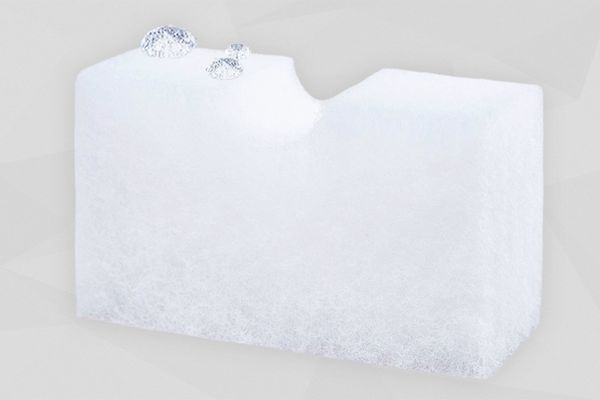Open-cell materials: Effective sound insulation for machines, vehicles and rooms
Open-cell materials are foams whose cells are interconnected, allowing air and sound waves to pass through the material. This structure makes open-cell foams particularly effective at absorbing sound, as they scatter and dampen sound waves inside them.
Another example of open-cell materials are PES non-wovens (polyester non-wovens), which also have excellent sound-absorbing properties due to their fibrous, open structure. They are often used in acoustic applications because they are lightweight, dimensionally stable and versatile.
Advantages of open-cell materials
Open-cell foams and polyester non-woven offer excellent sound absorption properties and are therefore ideal for use in various technical and industrial applications. They are lightweight, flexible and easy to process, making them a popular choice for sound insulation.
These materials are also frequently used in room acoustics, i.e. the acoustic design of rooms with hard, sound-reflecting surfaces. Thanks to their sound-absorbing properties, they contribute significantly to reducing reverberation times and improving speech intelligibility.
PES non-wovens
PES non-wovens (polyester non-wovens) are a special type of open-cell material that is particularly effective at sound absorption due to its structure and composition. They offer good strength and high dimensional stability, making them ideal for use in various technical applications.
Cellofoam has the following PES non-woven products in its range:
- Cello® F700 FR HO
- Cello® F700 FR HO ALG-01 (polyester non-woven with aluminium surface)
- Cello® F700 FR HO ALG-01 DRAIN (product for draining condensation)
- Cello® F700 FR HO HT (polyester non-woven with film surface)
- Cello® F800 FR
- Cello® F800 FR ALG-01 (polyester non-woven with aluminium surface)
- Cello® F800 FR CB (polyester non-woven with foil seal)
- Cello® 852-01 (compacted polyester non-woven)
- Cello® Compressor jacket
- Cello® S400 (seat cushion non-woven)


In addition to the PES non-wovens already mentioned, Cellofoam offers a wide range of other open-cell sound insulation materials that are characterised by their high acoustic effectiveness and versatile applications:
Melamine resin foams (e.g. Cello® HR 290)
- Based on Basotect®
- Very light, fine-celled and open-pored
- Excellent sound absorption in the mid and high frequency range
- Optionally available with laminated surfaces (e.g. aluminium, fleece, foil) for additional functionality
- Use in vehicle cabins, machine cladding, building services engineering
PUR acoustic foams (e.g. Cello® 470, 471, 521, 441, 491)
- Open-cell structure with high air permeability
- Variants with dimpled structure or sealed surface
- Good absorption across a wide frequency range
- Particularly suitable for applications with complex geometries or high flexibility requirements
Areas of application for open-cell materials
- Machinery and vehicles: Open-cell materials are used in machinery and vehicles, including buses and rail vehicles, to reduce noise generated by engines and mechanical components.
- Heat pumps: Heat pumps generate noise during operation, which can be effectively insulated using open-cell materials.
- Medical technology: In medical technology, a quiet environment is of great importance. Open-cell materials are used here to minimise the noise generated by medical devices and equipment.
- Cabins/capsules and hoods: In cabins, capsules and under hoods, as used in industry, protection against sound is important. Open-cell materials help to reduce noise pollution.
- Rail vehicles: Rail vehicles are particularly susceptible to noise generated by movement on the tracks. Open-cell materials such as polyester fleece are used here to control noise levels.
- Construction and agricultural machinery: Construction and agricultural machinery generate considerable noise due to the way they operate. Open-cell materials are used to reduce noise pollution.
- Room acoustics: Open-cell materials also play an important role in room acoustics. Their sound-absorbing properties can reduce reverberation, resulting in more pleasant acoustics.
Cellofoam products for the application of open-cell materials
Cellofoam offers a wide range of products specially developed for sound absorption and damping. Our open-cell materials, including PES non-wovens, are designed to be used effectively in various industrial and technical applications.
These materials are lightweight, flexible and offer excellent sound-absorbing properties that help to significantly reduce noise pollution in machines, vehicles, heat pumps, medical technology, cabins, capsules, hoods, rail vehicles, construction and agricultural machinery, and room acoustics. With Cellofoam solutions, you can create a quieter and more pleasant environment.









